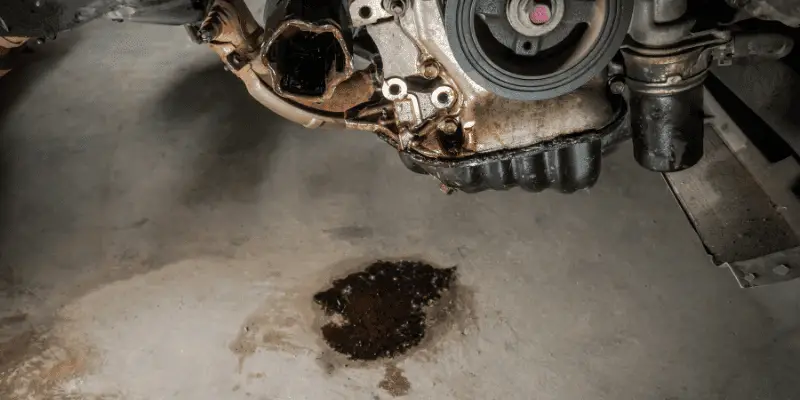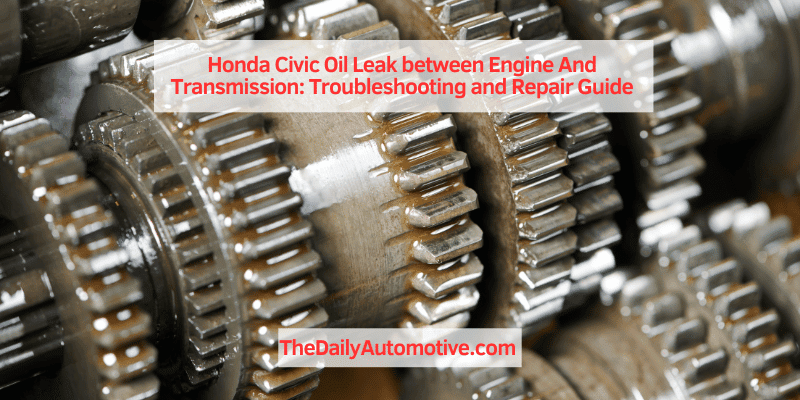Honda Civic Oil Leak between Engine And Transmission: Troubleshooting and Repair Guide
The Honda Civic can experience an oil leak between the engine and transmission. This can be caused by a faulty seal or gasket in the area where the two components meet.
Oil leaks can be quite a nuisance for car owners, as they not only lead to a messy engine bay but can also cause serious damage if left unchecked. One common area for oil leaks in the Honda Civic is between the engine and transmission.
This can be a result of a faulty seal or gasket, which allows the oil to escape from the engine and seep into the transmission area. Identifying and addressing this issue promptly is important to prevent further damage and ensure the smooth operation of your Honda Civic. We will explore the causes of oil leaks between the engine and transmission in a Honda Civic, as well as the potential consequences and solutions.
Signs Of An Oil Leak In Honda Civic
An oil leak between the engine and transmission in a Honda Civic can be indicated by visible oil spots on the ground, a burning oil smell, low oil levels, or engine overheating. Promptly addressing these signs can prevent further damage to the vehicle.
Do you own a Honda Civic? If so, it’s important to be aware of potential signs of an oil leak between the engine and transmission. Catching an oil leak early can prevent more significant damage to your vehicle and save you from costly repairs down the road.
Here are a few indicators that you may have an oil leak in your Honda Civic:
Oil Spots On The Driveway Or Garage Floor:
- Notice any dark, wet spots near the front or center of your vehicle after it has been parked? These spots could be a result of an oil leak. Keep an eye out for any fresh oil stains on your driveway or garage floor.
Burning Smell From The Engine:
- Have you noticed a strong, burning odor coming from the engine compartment of your Honda Civic? This could be a sign of an oil leak. When oil drips onto hot engine components, it can create a distinctive burning smell.
Low Oil Level On The Dipstick:
- Regularly checking your Honda Civic’s oil level is crucial in detecting an oil leak. If you find that the oil level is consistently low on the dipstick, it may indicate that oil is escaping from the engine or transmission.
Increased Engine Temperature:
- Is your Honda Civic’s engine running hotter than usual? An oil leak can disrupt the engine’s cooling process, leading to increased temperatures. If you notice that your engine temperature gauge is consistently higher than normal, it may be time to inspect for an oil leak.
Remember, if you suspect an oil leak in your Honda Civic, it’s best to have it checked by a professional mechanic. They can diagnose the issue accurately and determine the best course of action to address the leak. Early detection and repair can help preserve the performance and longevity of your Honda Civic.
Causes Of Oil Leak In Honda Civic
The Honda Civic may experience oil leaks between the engine and transmission due to various causes, such as worn-out gaskets, faulty seals, or damaged oil pan. These issues can lead to oil dripping onto the ground and require prompt attention to prevent further engine damage.
The Honda Civic is known for its reliability and efficiency. However, like any other vehicle, it is not exempt from common issues such as oil leaks. If you notice an oil leak between the engine and transmission of your Honda Civic, several potential causes could be to blame.
Here are the most common culprits to consider:
Worn-Out Oil Pan Gasket:
- The oil pan gasket is located at the bottom of the engine and helps seal the oil pan to prevent leaks.
- Over time, the gasket can deteriorate, leading to oil leaks between the engine and transmission.
- Constant exposure to heat, oil, and other factors can contribute to the gasket becoming worn and ineffective.
Faulty Crankshaft Seal:
- The crankshaft seal is responsible for keeping oil from leaking out of the front or rear of the engine.
- If the seal becomes damaged or worn, it can lead to an oil leak between the engine and transmission.
- Factors such as high mileage, wear and tear, or improper installation can cause the seal to fail.
Damaged Oil Cooler Lines:
- The oil cooler lines are responsible for circulating oil to cool down the engine.
- If the lines become damaged due to corrosion, rust, or physical impact, they can develop leaks.
- A damaged oil cooler line can result in oil escaping and pooling between the engine and transmission.
Failing Valve Cover Gasket:
- The valve cover gasket is located on top of the engine and helps seal the valve cover to prevent oil leaks.
- Over time, the gasket can deteriorate, leading to oil seepage between the engine and transmission.
- Inadequate sealing can be caused by aging, heat, or improper installation of the gasket.
If you’re experiencing an oil leak between the engine and transmission in your Honda Civic, it’s crucial to identify and address the cause promptly. Whether it’s a worn-out oil pan gasket, faulty crankshaft seal, damaged oil cooler lines, or failing valve cover gasket, understanding the potential causes can help you take the necessary steps to prevent further damage and maintain the performance of your beloved Honda Civic.
Remember to consult with a qualified mechanic for an accurate diagnosis and appropriate repairs.
Identifying The Source Of The Oil Leak
Discovering the origin of an oil leak in a Honda Civic, specifically between the engine and transmission, can be crucial for proper repair and maintenance. By accurately identifying the source, you can address the issue promptly, ensuring the longevity and optimal performance of your vehicle.
The Honda Civic is a popular and reliable car, but like any vehicle, it can experience issues such as oil leaks. If you’ve noticed an oil leak between the engine and transmission of your Honda Civic, it’s crucial to identify the source promptly.
In this section, we will discuss the possible culprits for the oil leak and provide some guidance for pinpointing the exact location. Let’s dive in and explore the potential sources:
Inspecting The Oil Pan Gasket:
- Check the oil pan gasket for any signs of wear or damage.
- Look for oil pooling or dripping around the area where the oil pan attaches to the engine block.
- If you notice oil seeping through the gasket, it may need to be replaced to resolve the leak.
Checking The Crankshaft Seal:
- Examine the crankshaft seal, located at the rear of the engine, where it meets the transmission.
- Look for any signs of oil accumulation or dripping near the seal.
- If the seal is damaged or worn-out, it can cause an oil leak, and replacing it might be necessary.
Examining The Oil Cooler Lines:
- Inspect the oil cooler lines for any signs of leakage.
- Pay close attention to connections and joints where the lines meet the engine or transmission.
- If you notice oil seeping from a connection or a damaged line, it may need to be repaired or replaced to stop the leak.
Assessing The Valve Cover Gasket:
- Look for oil stains or oil pooling around the valve cover area.
- Inspect the gasket for any visible signs of deterioration or damage.
- If the valve cover gasket is compromised, it can lead to an oil leak, and replacing it is typically the solution.
By following these guidelines and performing a thorough inspection, you can identify the source of the oil leak between the engine and transmission in your Honda Civic. Remember, it’s essential to address the issue promptly to prevent further damage and ensure the longevity of your vehicle.
If you’re unsure or unable to diagnose the problem yourself, it’s always wise to consult with a professional mechanic for expert advice and assistance.
Diy Temporary Fixes For A Honda Civic Oil Leak
Discover DIY temporary fixes for an oil leak between the engine and transmission of your Honda Civic. Learn simple and effective methods to address the issue and restore the smooth functioning of your vehicle. Get step-by-step instructions and expert tips for a quick resolution.
If you notice that your Honda Civic has an oil leak between the engine and transmission, it’s important to address the issue promptly to avoid further damage. While it’s always recommended to have a professional mechanic look into the problem, there are some temporary fixes you can try to minimize the leak until proper repairs can be made.
Using Oil Stop Leak Additives:
- Oil stop leak additives can be a quick and easy solution to temporarily reduce or stop an oil leak in your Honda Civic.
- Add the recommended amount of oil stop leak additive to your engine oil according to the product instructions.
- The additives are designed to rejuvenate and swell the seals, gaskets, and O-rings, helping to prevent or reduce the oil leak.
- It’s important to note that oil stop leak additives are not a permanent fix and should only be used as a temporary solution until you can get the leak properly repaired by a professional.
Applying Sealants To Leaking Areas:
- Another temporary fix for a Honda Civic oil leak is using sealants specifically designed for engine leaks.
- Clean the leaking area thoroughly to ensure proper adhesion of the sealant.
- Apply the sealant directly to the leaking area, following the product instructions for the amount and application method.
- Allow the sealant to cure and form a tight seal that can help minimize or stop the oil leak temporarily.
- Keep in mind that sealants are not a long-term solution and should only be used temporarily until you can have the leak repaired by a professional.
Replacing Damaged Hoses Or Lines Temporarily:
- If you identify damaged hoses or lines as the source of the oil leak, a temporary fix can be to replace them.
- Locate the damaged hoses or lines in your Honda Civic and carefully remove them.
- Obtain temporary replacement hoses or lines from an auto parts store and install them in place of the damaged ones.
- Ensure that the replacements are securely attached and properly connected to the engine and transmission.
- This temporary solution should only be used until you can have the damaged hoses or lines replaced with new ones by a professional mechanic.
Remember, while these DIY temporary fixes can help minimize or stop a Honda Civic oil leak temporarily, it’s crucial to have the issue properly diagnosed and repaired by a professional mechanic as soon as possible to avoid further damage and ensure your vehicle’s long-term performance and reliability.
Repairing The Oil Leak In Honda Civic
Repairing the oil leak between the engine and transmission in your Honda Civic is crucial to ensure optimal performance. Trust our expert technicians to fix the issue efficiently and get you back on the road smoothly.
Honda Civic is a reliable and popular vehicle choice for many drivers. However, one issue that some Honda Civic owners may encounter is an oil leak between the engine and transmission. This can be a cause for concern as it can lead to further damage if not addressed promptly.
In this blog post, we will discuss how to repair the oil leak in a Honda Civic, focusing on specific areas such as the oil pan, crankshaft seal, oil cooler lines, and valve cover gasket. By following these steps, you can effectively resolve the oil leak and ensure the longevity of your Honda Civic.
Removing The Oil Pan And Replacing The Gasket:
- Start by lifting the front end of the vehicle using a jack and securely placing it on jack stands.
- Locate the oil pan underneath the engine and use a socket wrench to remove the bolts securing it in place.
- Carefully lower the oil pan and clean the surface where the gasket sits to ensure a proper seal.
- Install a new gasket and reattach the oil pan, tightening the bolts in a star pattern to ensure even pressure.
- Finally, lower the vehicle and refill the engine with the appropriate amount of oil.
Replacing The Crankshaft Seal:
- Remove any components obstructing access to the crankshaft seal, such as the drive belts or harmonic balancer.
- Use a suitable tool to pry out the old seal, taking care not to damage the surrounding area.
- Apply a small amount of engine oil to the new seal to lubricate it and aid in installation.
- Carefully press the new seal into place, ensuring it is seated evenly and flush with the surface.
- Reinstall any previously removed components and ensure they are properly tightened.
Repairing Or Replacing The Oil Cooler Lines:
- Locate the oil cooler lines, which are typically positioned near the radiator or front of the engine.
- Inspect them thoroughly for signs of damage or leaks, such as cracks, bulges, or loose fittings.
- If repairs can be made, use high-quality hose clamps or fittings to secure any loose connections.
- If the oil cooler lines are severely damaged or cannot be repaired, they should be replaced with new ones.
- Once repairs or replacements are complete, inspect the area again to ensure there are no leaks.
Removing And Replacing The Valve Cover Gasket:
- Begin by disconnecting any components that may hinder access to the valve cover, such as the spark plug wires or ignition coil.
- Use a socket wrench to loosen and remove the bolts securing the valve cover in place.
- Gently lift off the valve cover, being cautious not to damage the gasket or surrounding components.
- Clean the mating surface of the valve cover and cylinder head to remove any oil or debris.
- Install a new valve cover gasket and carefully reattach the valve cover, tightening the bolts evenly and in a crisscross pattern.
By following these steps, you can effectively repair the oil leak in your Honda Civic. It is crucial to address any oil leaks promptly to prevent further damage to your vehicle’s engine and transmission. Regular maintenance and inspections will help ensure the longevity and reliability of your Honda Civic.

Prevention And Maintenance For Honda Civic Oil Leaks
Prevent and maintain your Honda Civic’s oil leak between the engine and transmission with these tips to keep your car running smoothly. Fixing this issue early can prevent costly repairs down the line.
If you own a Honda Civic, it’s essential to prioritize prevention and maintenance to avoid oil leaks between the engine and transmission. Regular inspections, replacing gaskets and seals as recommended, and adhering to oil change intervals are vital for keeping your vehicle in top condition.
By following these proactive steps, you can minimize the risk of oil leaks and ensure smooth and reliable performance. Let’s delve into each aspect in more detail:
Regularly Inspecting The Engine For Leaks
To prevent oil leaks from becoming a bigger issue, it’s crucial to undertake regular inspections of your Honda Civic’s engine. By keeping an eye on the following areas, you can catch potential leaks early on:
- Oil filter housing: Check for any signs of oil seepage around the oil filter housing. If you notice any leakage, it may indicate a faulty gasket or seal.
- Engine oil pan: Inspect the engine oil pan for any signs of oil pooling or dripping. This can suggest a damaged gasket or a loose drain plug.
- Valve cover gasket: Look for any oil residue around the valve cover gasket. If you notice any leakage, it may be time to replace the gasket.
- Oil pressure switch: Check the area around the oil pressure switch for any signs of oil seeping. A faulty switch can contribute to oil leaks.
By regularly inspecting these areas and promptly addressing any issues, you can prevent oil leaks from worsening and potentially causing more significant damage to your Honda Civic.
Replacing Gaskets And Seals As Recommended
Gaskets and seals play a critical role in preventing oil leaks in your Honda Civic. Over time, these components can deteriorate and lose their effectiveness. It’s essential to follow the manufacturer’s recommendations and replace them when necessary. Here are some key gaskets and seals to keep an eye on:
- Valve cover gasket: This gasket keeps oil from leaking out of the valve cover. Inspect it regularly and replace it if signs of deterioration are present.
- Oil pan gasket: Responsible for sealing the oil pan to the bottom of the engine, this gasket should be replaced if you notice oil pooling or dripping from the pan.
- Transmission input seal: Found where the engine and transmission connect, this seal prevents oil from leaking between the two components. If you detect oil leakage in this area, it’s crucial to replace the seal.
By proactively replacing worn-out gaskets and seals, you can minimize the risk of oil leaks and maintain the optimal performance of your Honda Civic.
Changing The Oil And Filter At Recommended Intervals
Regular oil changes are a fundamental aspect of preventing oil leaks in your Honda Civic. Following the manufacturer’s recommended intervals for oil and filter changes ensures that your engine is supplied with clean, fresh oil. Here are a few key points to remember:
- Use high-quality oil: Opt for the recommended oil type and quality specified by Honda for your Civic. Using the right oil can help prevent premature degradation and potential leaks.
- Replace the oil filter: When changing the oil, don’t forget to replace the oil filter as well. A clogged or worn-out filter can impede oil flow and lead to leaks.
- Adhere to the recommended intervals: Regularly changing the oil and filter at the suggested intervals ensures proper lubrication and reduces the likelihood of oil leaks.
By maintaining a consistent oil change schedule and using the appropriate oil and filter, you can safeguard your Honda Civic against oil leaks and extend the lifespan of your engine.
Remember, taking preventative measures and performing regular maintenance on your Honda Civic can go a long way in preventing oil leaks between the engine and transmission. By inspecting your engine for leaks, replacing gaskets and seals as needed, and changing oil and filters at recommended intervals, you can keep your Honda Civic running smoothly and reduce the risk of oil leaks.
Stay proactive, and ensure your vehicle remains in excellent condition for years to come.
Frequently Asked Questions For Honda Civic Oil Leak Between Engine And Transmission
Why Is Oil Leaking Between Engine And Transmission?
Oil leaks between the engine and transmission can occur due to damaged seals or gaskets.
What Causes Oil Leaks In Honda Civic?
Oil leaks in Honda Civics can be caused by worn gaskets, seals, or damaged oil pans.
Does The Rear Main Seal Leak Engine Oil Or Transmission Fluid?
The rear main seal can leak engine oil but not transmission fluid.
How Do You Know If Your Rear Main Seal Is Leaking?
The rear main seal may be leaking if there is oil dripping from the back of the engine.
Conclusion
Addressing an oil leak between the engine and transmission in your Honda Civic is crucial to maintain its performance and prevent further damage. By understanding the common causes, such as a faulty gasket or seal, and taking necessary precautions, you can mitigate the risk of encountering this issue.
Regularly inspecting your vehicle for signs of oil leaks and promptly addressing any concerns can save you from costly repairs down the line. Whether you choose to tackle the problem yourself or seek professional help, make sure to use high-quality replacement parts and follow the recommended procedures.
Remember, maintaining the health of your engine and transmission is essential for a smooth and efficient driving experience. Don’t wait until it’s too late – be proactive in addressing oil leaks to keep your Honda Civic running smoothly for years to come.









4 Comments